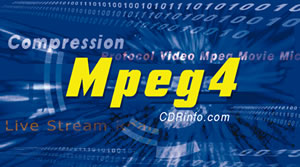MPEG-4 Overview
1. Part 1
MPEG-4: The Interactive Revolution - Page 1
 MPEG-4
is an ISO standard (ISO/IEC international standard 14496) developed by the
Moving Picture Experts Group (MPEG). It defines the deployment of non-proprietary
multimedia content independently of platform or transmission medium. It has
relied on and taken from a number of existing technologies while at the same
time adding a number of innovative tools and concepts.
MPEG-4
is an ISO standard (ISO/IEC international standard 14496) developed by the
Moving Picture Experts Group (MPEG). It defines the deployment of non-proprietary
multimedia content independently of platform or transmission medium. It has
relied on and taken from a number of existing technologies while at the same
time adding a number of innovative tools and concepts.
It is also more than just another highly efficient standard for delivering video and audio sequences. It integrates a number of key technologies into a solid and uniform platform by avoiding the use of proprietary and non inter-working formats, while promoting and delivering user interactivity to the wider consumer market, beyond the desktop computer.
Traditional radio and television broadcasting has up until now been a process of preparing the entire presentation at the point of origin (i.e. radio or TV studio), where the individual components, such as video footage, titles, background music, voice over, etc, are mixed together in the studio, modulated onto a carrier and transmitted over the airwaves.
An internet web page presentation on the other hand, does exactly the opposite. All the mixing and rendering is performed at the receiver i.e. the user’s computer. A server sends the makeup of the presentation in textual form as a series of commands using a language known as HyperText Markup Language or HTML. The receiving programme, known as a web browser, interprets the commands and then negotiates the download of each component used in the presentation, which it then renders on the user’s screen.
There are pros and cons with each system. Perhaps the biggest difference between them is that broadcast TV is a one-way communications system, where the viewer is passive, whereas with the internet, the user is an active participant. However, broadcast TV offers much better quality and performance for real time transmission of video content.
The above comparison provides an insight into part of what the MPEG-4 standard attempts to integrate. In the executive overview of the Overview of the MPEG-4 Standard from the International Organization for Standardization (ISO), the following extract summarizes very succinctly what the aim of the standard is:
MPEG-4 builds on the proven success of three fields:
- Digital television
- Interactive graphics applications (synthetic content)
- Interactive multimedia (World Wide Web, distribution of and access to content)
MPEG-4 provides the standardized technological elements enabling the integration of the production, distribution and content access paradigms of the three fields.
Probably the major advancement that MPEG-4 introduces is a new level of interactivity, where the user (not just a viewer anymore) takes part in the presentation. This interactivity is even more pronounced than it is with the internet.













